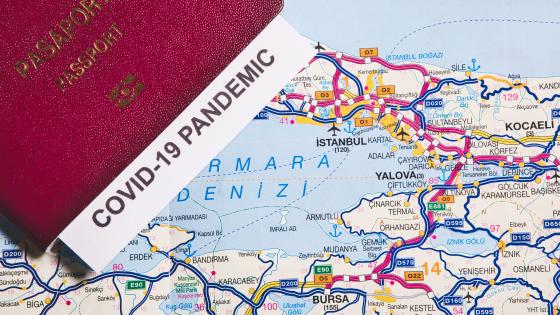After announcing via Twitter his intention to temporarily halt immigration to the US in “light of the attack from the Invisible Enemy”, Donald Trump signed an executive order to pause the issuance of green cards for 60 days. At the same time, however, it was announced that the ban will not apply to farm workers, implicitly recognising that a crucial component of the COVID-19 response is coming from abroad. The value of migrant workers for the US emergency economy has been quantified in a recent note by the Migration Policy Institute (Gelatt 2020), which estimates that foreign born workers account for 19% of the US workers in frontline essential industries, while making up approximately 17% of the employed workforce.
In Europe, public policies affecting migration and the surrounding political discourse in the middle of the pandemic, have taken a different path. Italy, for instance, is currently discussing the possibility of granting an amnesty for undocumented immigrants, mixing the concern about labour shortages in the agricultural and personal care sectors with the willingness to provide these workers with some form of social and health protection. Portugal has announced that it will grant temporary residence permits to all asylum seekers who had their application still pending. And Sweden has announced a 12-month extension to several labour market integration programmes allowing migrants whose subsidies would expire in the near future to remain employed.
The COVID-19 response in Europe: Lockdowns and key workers
The rapid spread of the COVID-19 contagion has induced many EU member states to temporarily shut down large sections of their economies with the aim of slowing down the virus propagation rate and allowing national health systems to offer adequate care to all citizens seriously affected. While the forced shut down has confined large fractions of the workforce at home, some essential functions still need to be performed in order to keep European citizens healthy, safe and fed during the pandemic. ‘Key workers’ are performing these crucial tasks on the front line of Europe's COVID-19 response. Understanding who these workers are and under which conditions they can effectively continue the provision of their essential services is a crucial element of any informed strategy to cope with the pandemic. A major concern here is whether ‘key workers’ belong to categories of individuals that may be particularly vulnerable during the crisis. The government-imposed heterogeneity in the lockdown across occupations and industries will obviously lead to differential impact of the recession on different groups of workers based on their pre-COVID-19 employment. In addition, we can expect economic impacts of the pandemic to further vary by age, gender, household structure, type of employment contract, firm size, etc. (Bell et al. 2020, Adams-Prassl et al. 2020, Hupkau and Petrongolo 2020). The nationality of workers is another important variable to take into account. Since immigrants are typically more exposed to economic downturns than natives (Dustmann et al. 2010), assessing their involvement in key occupations is the first step to conceive interventions that may reduce their vulnerability.
Immigrant key workers in Europe: How many and where?
How many immigrants are employed in the occupations that have been identified as essential in the response to the COVID-19 pandemic in the EU? We address this question in joint work with Jacopo Mazza (J.R.C. European Commission) (Fasani and Mazza 2020). We base our analysis on the most recent wave (2018) of the EU Labour Force Survey (EU-LFS). We restrict our sample to employed workers in the 15 to 64 age bracket and distinguish two main groups of migrants (EU mobile and extra-EU citizens) based on their country of birth. Finally, we identify the list of key occupations by combining information from the European Commission and the Dutch government.
According to our definitions and estimates, approximately 31% of employed working-age individuals are key workers in the EU, although this share varies widely across Europe, from over 40% in Denmark and France to just above 10% in Bulgaria and Slovenia. On average, 13% of key workers are immigrants in the EU. Figure 1 shows wide variation across member states: The share of immigrant key workers is close to zero in Eastern European countries such as Romania, Bulgaria, Poland and Slovakia, while it fluctuates around 20% in countries such as Italy, Belgium, Germany, Sweden and Austria. The largest figures are observed in Ireland (26%), Cyprus (29%) and Luxembourg (53%). In most countries, the share of Extra-EU key workers is larger than the EU-mobile share.
Figure 1 Share of Immigrants among key workers, by EU member state
Notes: The bars report the percentage of immigrants over total key workers for each Member state. The red dotted line represents the average share of immigrant key workers across the EU (13%).
Source: EULFS (2018) data.
A substantial fraction of the variation we observe in Figure 1 is driven by differences in the overall share of migrants residing in each country. To take into account this aspect, in Figure 2 we compare the share of migrants among key workers (blue bars) to the share of migrants in the employed population (red dots). The figure refers exclusively to extra-EU citizens. The dots tend to lie below the bars, implying that extra-EU workers are actually overrepresented among key workers relative to their prevalence in the general population of workers. The largest difference is observed in Cyprus (where extra-EU migrants account for 13% of total workers, but for almost 20% of key workers), but relatively large gaps are observed also in major immigration countries such as Germany, Italy and Sweden. Notably, Extra-EU workers are slightly under-represented among key workers in just four member states (Czech Republic, Greece, Croatia and Slovenia), all of which are in Eastern Europe and have a relatively low share of migrants.
Figure 2 Extra-EU citizens: Share of migrant key workers versus share of migrant workers, by EU member state
Notes: For each EU member state, the bars report the share of migrants among key workers and the dots the share of migrant among the overall employed population.
Source: EULFS (2018) data.
Essential occupations and migrants
According to our definitions, the largest five categories of key workers in the EU are teaching professionals (14.5%), skilled agricultural workers (11.9%), science and engineering associate professionals (11.1%), personal care workers (10.3%) and cleaners and helpers (9.9%). Since natives are by far the most numerous group, their distribution across key occupations closely resembles the overall distribution. Important differences are visible instead for the two migrant groups, who appear to be far more concentrated in low-skill occupations. Indeed, the first three key occupational categories for EU mobile workers are cleaners and helpers (20.9%), personal care workers (12.5%) and teaching professionals (11.1%). The top two occupations are the same for extra-EU workers – cleaners and helpers (27.8%) and personal care workers (16.6%) – while the third most frequent occupation is drivers and mobile plant operators (9%).
Migrants' skills and educational attainments – combined with existing hurdles to the recognition of foreign qualifications and to the access to certain professions in the EU – will determine how represented foreign-born workers are in each occupation. In most member states, EU-mobile key workers are predominantly middle or highly educated, while extra-EU key workers tend to have lower education (especially in countries such as Italy, Spain, Portugal and Greece). This is partly due to the original skill distribution of migrants in each country, as well as to the process of selection of individuals into migration. If we consider the concentration of migrants in key occupations by educational level (low, middle, high), we see that, irrespective of their level of education, EU-mobile workers' concentration in key occupations closely follows that of the native population. The overrepresentation of extra-EU workers in key occupations is driven by a strong overrepresentation of low educated migrants.
Figure 3 Share of immigrants among key workers, by occupation
Notes: For each occupation, the bars report the percentage of immigrants over total key workers for each occupation.
Source: EULFS (2018) data.
Finally, in Figure 3 we consider the entire EU area and report the share of foreign-born key workers by occupation. The figure clearly shows how heavily some key occupations rely on migrant workers. While foreign-born workers account for 13% of key workers in the EU (see Figure 1), in many key occupations we observe shares that are substantially higher. For example, more than a third of cleaners and helpers, more than a quarter of labourers in mining and construction sectors, stationary plant and machine operators and one in five workers in food processing are migrants. Extra-EU citizens alone account for more than 25% of cleaners and helpers, 17% of mining and construction workers and 14% of personal care workers.
Conclusions
There are two major lessons for policymaking arising from this evidence. First, migrant workers are playing a critical role in performing basic functions in EU societies hit by the COVID-19 epidemic. This calls for interventions in the short run that may allow foreign-born workers to better cope with the crisis and keep contributing to its solution. Second, low-educated migrants – and not just high-skilled ones – are employed in occupations that are key for hosting societies. This latter fact suggests the need for reconsidering – in the aftermath of the pandemic crisis – a migration policy debate which is currently almost entirely focused on the importance of attracting high skilled migrants to the EU.
References
Adams-Prassl, A, T Boneva, M Golin and C Rauh (2020) “The large and unequal impact of COVID-19 on workers”, VoxEU.org, 8 April.
Bell, B, N Bloom, J Blundell, L Pistaferri (2020) “Prepare for large wage cuts if you are younger and work in a small firm”, VoxEU.org, 6 April.
Dustmann, C, A Glitz and T Vogel (2010), "Employment, wages, and the economic cycle: Differences between immigrants and natives," European Economic Review 54(1): 1-17.
Fasani, F and J Mazza (2020) “Immigrant Key Workers: Their Contribution to Europe's COVID-19 Response”, IZA Policy Paper No. 155
Gelatt, J (2020) “Immigrant Workers. Vital to the U.S. COVID-19 Response, Disproportionately Vulnerable”, Migration Policy Institute, Factsheet, April.
Hupkau, C and B Petrongolo (2020) “COVID-19 and gender gaps: Latest evidence and lessons from the UK”, VoxEU.org, 22 April.



